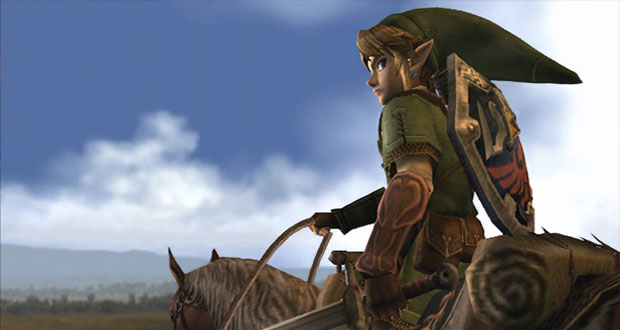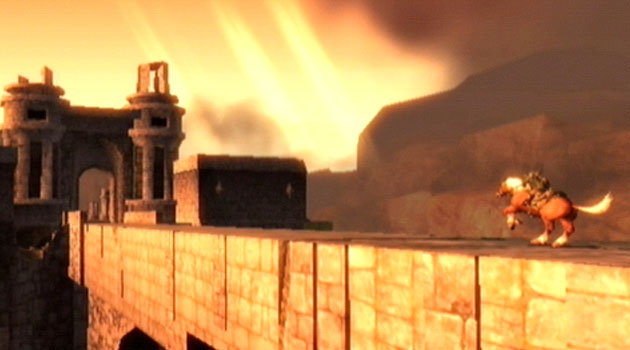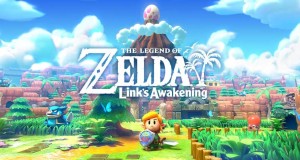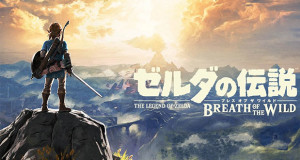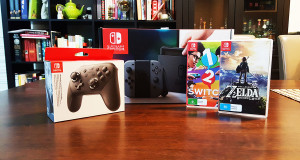In the history of The Legend of Zelda games, it doesn’t get any better than Twilight Princess. Here is a game that is the almighty culmination of all the previous Zelda games rolled into one epic adventure. Legend of Zelda: Twilight Princess is rich with history and mythos in a way that almost no other game franchise can compete with and in this title’s fifty-odd hours of gameplay, the game revisits many familiar game mechanics and concepts from its 20 years of exploration and adventuring.
This is not to say that the game rests on its laurels as most of the concepts familiar to fans of the series are thematic or game concepts rather than tangible objects within the environment. As with most of the Zelda games since Link to the Past on the Super Nintendo, there are dual worlds for Link to travel between and Twilight Princess pushes this idea even further by having Link transform between a human and wolf form in both worlds which affects the dynamics and interaction Link has with his environment.
For all the intricacies in the game design and play elements, Twilight Princess still retains a degree of simplicity and open endedness in its story. Link starts the story as a ranch hand in a little village called Ordon. When a group of monsters attack Link and warp him into the Twilight realm, he is transformed into a wolf and meets an impish creature named Midna who becomes his companion for the rest of the game. As with all previous Zelda games, Link is set the task of retrieving a Macguffin from the depths of various dungeons to save the Princess and save the world. However he remains almost entirely mute during the game and the difficulty curve can be scaled entirely by the gamer. As the dungeons in Twilight Princess increase in difficulty, each boss that is slain yields a heart to increase Link’s life meter. The player is always given a choice whether to accept this so the degree of difficulty in the game can be measured by how aggressively the player pursues these hearts (they can also be found as rewards in sidequests).
Graphically, the game is spectacular. Although the amazement at the game’s technical achievement have lost most lot of its lustre since its original teaser trailer in 2004, the game still stands tall in its character design and dynamic set pieces. As well as being a homage to dungeon and character designs from previous Zelda games, the game also has some action sequences that evoke memories of The Lord of the Rings films, Shadow of the Colossus on Playstation 2 and other fantasy works. I especially liked the game’s implementation of the nightmarish Twilight Realm and the design of the creatures that populate it. The entire cast of characters, although they say very little, are also very expressive with their facial expressions and body language.
Twilight Princess is the first Zelda game to get a Teen rating and this partly due to the graphical design which has a much darker palate that previous installments of the series. Given the games open-ended nature and minimalist approach to narrative, the story and the creatures can also be as dark as your imagination lets it be and the game gives plenty of scope for doing so. A strong recurring theme in the game is loneliness and we see it in a child name Colin who is bullied by his peers, a rather desperate barkeep named Telma who pines for a village shaman and Midna, who doesn’t seem to be at home in either the Light or the Twilight realm.
Worldwide, the game is comfortably the most popular launch title for the Wii after Wii Sports, which comes bundles in all countries except for Japan. This is something of a paradox given Nintendos mission statement to make the Wii as accessible as possible. Twilight Princess is resolutely a gamer’s game that demands great time investment, concentration and co-ordination with the controller. It is hard to imagine a new convert from Wii Sports making the leap to this game. Given the long development cycle for Twilight Princess though, it was likely that the game was already in the middle of creation when the new direction and concept for the Wii was decided.
So where does the series go to from here? There is a new title coming to the DS later this year but what can possibly be next for the series on home consoles. One feels that the game has reached a creative and design apex from which there can now only be an entirely new direction to take. Whether this would be giving Link a voice and a more complicated narrative or reconsidering the nature of play and the design template for its dungeons, who knows. As it stands though, Legend of Zelda: Twlight Princess stands tall as one of the most satisfying games ever made and another classic addition to this legendary series.
Review Overview
RATING
GREAT
Summary : A fantastic successor to Wind Waker that has some terrific new dungeons, interesting integration of motion controls and some surprising cinematic influences.
 The FAT Website est. 1999
The FAT Website est. 1999

